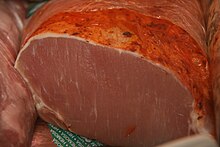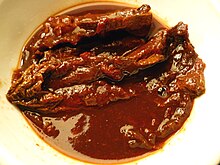
Back Adobáu AST Adobo BCL আদোবো Bengali/Bangla Adobo German Adobo Spanish Adobo Basque Adobo French Adobo (gastronomía) Galician Adobo ID Adobo Italian
 Lomo en adobo—pork loin marinated in adobo | |
| Type | Sauce or marinade |
|---|---|
| Place of origin | Spain, Portugal |
| Main ingredients | Paprika, salt, garlic and vinegar |


Adobo or adobar (Spanish: marinade, sauce, or seasoning) is the immersion of food in a stock (or sauce) composed variously of paprika, oregano, salt, garlic, and vinegar to preserve and enhance its flavor. The Portuguese variant is known as carne de vinha d'alhos. The practice, native to Iberia (Spanish cuisine[1] and Portuguese cuisine), was widely adopted in Latin America, as well as Spanish and Portuguese colonies in Africa and Asia.
In the Philippines, the name adobo was given by colonial-era Spaniards on the islands to a different indigenous cooking method that also uses vinegar.[2][3] Although similar, this developed independently of Spanish influence.[4][5][6]
- ^ Manuel Martinez Llopis (1989), Historia de la gastronomía española, Alianza editorial, ISBN 84-206-0378-3 (in Spanish)
- ^ Susana Aleson, Montse Clavé, (1998), Cocina filipina, ICARIA (in Spanish)
- ^ Cite error: The named reference
Indigenouswas invoked but never defined (see the help page). - ^ Cite error: The named reference
rodellwas invoked but never defined (see the help page). - ^ Estrella, Serna (June 22, 2013). "Adobo: The History of A National Favorite". Pepper.ph. Retrieved March 21, 2016.
- ^ Hosking, Richard (2006). Authenticity in the Kitchen: Proceedings of the Oxford Symposium on Food and Cookery 2005. Oxford Symposium. p. 299. ISBN 9781903018477.